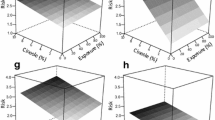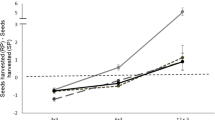Abstract
Cues for detecting and responding to perceived predation risk may be indirect, i.e., correlated with the probability of encountering a predator, or direct, i.e., produced by or related to the actual presence of a predator. Research shows, independently, both types of cues can influence anti-predator and foraging behaviours in prey species. However, since animals naturally encounter indirect and direct cues simultaneously, we were interested in quantifying their cumulative effect. Our aim was to evaluate food intake and behaviours (patch use, feeding (rate and time), vigilance) of a nocturnal mammalian herbivore to indirect (open vs. covered microhabitats; illumination) and direct (fox/owl odours) predator cues. We ran a preference trial with four paired treatments using a covered Safe food patch and an open Risk food patch, with one of four combinations of indirect and direct predator cues. Predation risk had a significant effect on both intake and behaviour (including feeding time, rate, and vigilance), but these effects differed depending on cues. No two combinations of cues produced exactly the same effects, illustrating the complexity of interactions that occur between cues. Covered patches were always perceived as less risky than open patches, but unexpectedly, open patches were perceived as riskier when dark rather than light. The strongest suite of (negative) responses to risk was associated with combined indirect and direct cues. These results highlight the importance of considering jointly, intake from a patch, intake rate, and behaviours, such as the proportion of time spent vigilant, when quantifying predation risk, rather than intake alone.





Similar content being viewed by others
References
Apfelbach R, Blanchard CD, Blanchard RJ, Hayes RA, McGregor IS (2005) The effects of predator odors in mammalian prey species: A review of field and laboratory studies. Neurosci Biobehav Rev 29:1123–1144. doi:10.1016/j.neubiorev.2005.05.005
Belton LE, Ball N, Waterman JM, Bateman PW (2007) Do Cape ground squirrels (Xerus inauris) discriminate between olfactory cues in the faeces of predators versus non-predators? African Zoology 42:135–138
Biebouw K, Blumstein DT (2003) Tammar wallabies (Macropus eugenii) associate safety with higher levels of nocturnal illumination. Ethol Ecol Evol 15:159–172
Bowers MA (1988) Seed removal experiments on desert rodents—the mircohabitat by moonlight effect. J Mammal 69:201–204
Bowers MA, Dooley JL (1993) Predation hazard and seed removal by small mammals—microhabitat versus patch scale effects. Oecologia 94:247–254
Brinkerhoff RJ, Haddad NM, Orrock JL (2005) Corridors and olfactory predator cues affect small mammal behavior. J Mammal 86:662–669
Brown JS (1988) Patch use as an indicator of habitat preference, predation risk, and competition. Behav Ecol Sociobiol 22:37–47
Brown JS (1999) Vigilance, patch use and habitat selection: foraging under predation risk. Evol Ecol Res 1:49–71
Brown JS, Kotler BP (2004) Hazardous duty pay and the foraging cost of predation. Ecol Lett 7:999–1014
Brown JS, Laundre JW, Gurung M (1999) The ecology of fear: optimal foraging, game theory, and trophic interactions. J Mammal 80:385–399
Cohen J (1988) Statistical power analysis for the behavioral sciences, 2nd edn. Lawrence Erlbaum Associates Inc, Publishers Hillsdale New Jersey
Cooke R, Wallis R, Hogan F, White J, Webster A (2006) The diet of powerful owls (Ninox strenua) and prey availability in a continuum of habitats from disturbed urban fringe to protected forest environments in south-eastern Australia. Wildl Res 33:199–206
Dearing MD, Cork S (1999) Role of detoxification of plant secondary compounds on diet breadth in a mammalian herbivore, Trichosurus vulpecula. J Chem Ecol 25:1205–1219
Fong TE, DeLong TW, Hogan SB, Blumstein DT (2009) The importance of indirect cues for white-browed sparrow-weaver (Plocepasser mahali) risk assessment. Acta Ethologica 12:79–85
Griffin PC, Griffin SC, Waroquiers C, Mills LS (2005) Mortality by moonlight: predation risk and the snowshoe hare. Behav Ecol 16:938–944
Iason GR, Van Wieren SE (1999) Digestive and ingestive adaptations of mammalian herbivores to low-quality forage. In: Olff H, Brown VK, Drent RH (eds) Herbivores; between plants and predators. Blackwell Science, Oxford, pp 337–370
Kavanagh RP (2002) Comparative diets of the powerful owl (Ninox strenua), sooty owl (Tyto tenebricosa) and masked owl (Tyto novaehollandiae) in southeastern Australia. In: Newton I, Kavanagh RP (eds) Ecology and conservation of owls: proceedings of the owls 2000, Canberra, Australia. CSIRO Publishing, Melbourne
Kerle JA (1984) Variation in the ecology of Trichosurus: its adaptive significance. In: Smith AP, Hume ID (eds) Possums and gliders. Australian Mammal Society, Sydney
Kotler BP (1984) Effects of illumination on the rate of resource harvesting in a community of desert rodents. Am Midl Nat 111:383–389
Kotler BP, Brown JS, Hasson O (1991) Factors affecting gerbil foraging behaviour and rates of owl predation. Ecology 72:2249–2260
Kotler BP, Gross JE, Mitchell WA (1994) Applying patch use to assess aspects of foraging behavior in Nubian ibex. J Wildl Manag 58:299–307
Kotler BP, Brown JS, Knight MH (1999) Habitat and patch use by hyraxes: there’s no place like home? Ecol Lett 2:82–88
Kotler BP, Brown JS, Bouskila A (2004) Apprehension and time allocation in gerbils: the effects of predatory risk and energetic state. Ecology 85:917–922
Kotler BP, Brown J, Mukherjee S, Berger-Tal O, Bouskila A (2010) Moonlight avoidance in gerbils reveals a sophisticated interplay among time allocation, vigilance and state-dependent foraging. Proceedings of the Royal Society B-Biological Sciences 277:1469–1474
Lima SL, Dill LM (1990) Behavioral decisions made under the risk of predation—a review and prospectus. Canadian Journal of Zoology-Revue Canadienne De Zoologie 68:619–640
MacLennan DG (1984) The feeding behaviour and activity patterns of the brushtail possum, Trichosurus vulpecula, in an open eucalypt woodland in southeast Queensland. In: Smith AP, Hume ID (eds) Possums and gliders. Australian Mammal Society, Sydney, pp 155–161
McDonald-Madden E, Akers LK, Brenner DJ, Howell S, Patullo BW, Elgar MA (2000) Possums in the park: efficient foraging under the risk of predation or of competition? Australian Journal of Zoology 48:155–160
Monclus R, Rodel HG, Von Holst D, De Miguel J (2005) Behavioural and physiological responses of naive European rabbits to predator odour. Anim Behav 70:753–761
Nersesian CL, Banks PB, McArthur C (2011) Titrating the cost of plant toxins against predators: determining the tipping point for foraging herbivores. J Anim Ecol 80:753–760. doi:10.1111/j.1365-2656.2011.01822.x
Orrock JL, Danielson BJ, Brinkerhoff RJ (2004) Rodent foraging is affected by indirect, but not by direct, cues of predation risk. Behav Ecol 15:433–437
Parsons MH, Blumstein DT (2010) Feeling vulnerable? Indirect risk cues differently influence how two marsupials respond to novel dingo urine. Ethology 116:972–980
Pickett KN, Hik DS, Newsome AE, Pech RP (2005) The influence of predation risk on foraging behaviour of brushtail possums in Australian woodlands. Wildl Res 32:121–130
Preisser EL, Bolnick DI (2008) When predators don’t eat their prey: nonconsumptive predator effects on prey dynamics(1). Ecology 89:2414–2415
Preisser EL, Bolnick DI, Benard MF (2005) Scared to death? The effects of intimidation and consumption in predator–prey interactions. Ecology 86:501–509
Ratkowsky DA, Evans MA, Alldredge JR (1993) Cross-over experiments: design, analysis and application. Marcel Dekker, New York
Ripple WJ, Beschta RL (2003) Wolf reintroduction, predation risk, and cottonwood recovery in Yellowstone National Park. For Ecol Manag 184:299–313
Ripple WJ, Beschta RL (2004) Wolves and the ecology of fear: can predation risk structure ecosystems? Bioscience 54:755–766
Schmidt KA (2006) Non-additivity among multiple cues of predation risk: a behaviorally-driven trophic cascade between owls and songbirds. Oikos 113:82–90
Scott SL, McArthur C, Potts BM, Joyce K (2002) Possum browsing—the downside to a eucalypt hybrid developed for frost tolerance in plantation forestry. For Ecol Manag 157:231–245
Shrader AM, Brown JS, Kerley GIH, Kotler BP (2008) Do free-ranging domestic goats show ‘landscapes of fear’? Patch use in response to habitat features and predator cues. J Arid Environ 72:1811–1819
Sih A (1980) Optimal behavior—can foragers balance 2 conflicting demands? Science 210:1041–1043
Soderquist T, Gibbons D (2007) Home-range of the powerful owl (Ninox strenua) in dry sclerophyll forest. Emu 107:177–184
Statham M, Statham HL (1997) Movements and habits of brushtail possums (Trichosurus vulpecula Kerr) in an urban area. Wildl Res 24:715–726
Thorson JM, Morgan RA, Brown JS, Norman JE (1998) Direct and indirect cues of predatory risk and patch use by fox squirrels and thirteen-lined ground squirrels. Behav Ecol 9:151–157
Weldon PJ (1990) Responses by vertebrates to chemicals from predators. In: Macdonald DW, Muller-Schwarze D, Natyrczuk SE (eds) Chemical signals in vertebrates. Oxford University, New York
While GM, McArthur C (2005) Foraging in a risky environment: a comparison of Bennett’s wallabies Macropus rufogriseus rufogriseus (Marsupialia: Macropodidae) and red-bellied pademelons Thylogale billiardierii (Marsupialia: Macropodidae) in open habitats. Austral Ecology 30:756–764
Wiggins NL, McArthur C, Davies NW, McLean S (2006) Spatial scale of the patchiness of plant poisons: a critical influence on foraging efficiency. Ecology 87:2236–2243
Willems EP, Hill RA (2009) Predator-specific landscapes of fear and resource distribution: effects on spatial range use. Ecology 90:546–555
Wolfe JL, Summerlin CT (1989) The influence of lunar light on nocturnal activity of the old-field mouse. Anim Behav 37:410–414
Acknowledgments
We thank Jan Nedved for his assistance at Cowan Field Station. The research was funded by an Australian Research Discovery Grant to Clare McArthur and Peter Banks; approved by the Animal Care and Ethics Committee of the University of New South Wales (project approval number 08/75B), conforms to the Australian Code of Practice for the Care and Use of Animals for Scientific Purposes, and performed under the New South Wales National Parks and Wildlife Act (1974) scientific license number: S12371.
Author information
Authors and Affiliations
Corresponding author
Additional information
Communicated by P. Bednekoff
Electronic supplementary materials
Below is the link to the electronic supplementary material.
ESM 1
(DOC 37 kb)
Rights and permissions
About this article
Cite this article
Nersesian, C.L., Banks, P.B. & McArthur, C. Behavioural responses to indirect and direct predator cues by a mammalian herbivore, the common brushtail possum. Behav Ecol Sociobiol 66, 47–55 (2012). https://doi.org/10.1007/s00265-011-1250-y
Received:
Revised:
Accepted:
Published:
Issue Date:
DOI: https://doi.org/10.1007/s00265-011-1250-y




